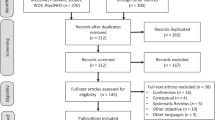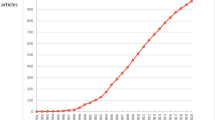Abstract
Studies of response-shift phenomena in quality-of-life (QOL) research have grown steadily in the more than two decades of research. As a field, we have been calling a lot of different approaches “response shift” over the years, but the only approach that fully embodies the foundational (Sprangers and Schwartz, Soc Sci Med 48(11):1507–1515, 1999) theoretical model is appraisal. According to the definition proposed in this model, response shift is about individual cognitive change. This paper presents the argument that all response-shift research models need to be grounded in an understanding of cognitive appraisal. We present a reasoned argument for why appraisal is fundamental to QOL response-shift research. We describe current measurement and analytic methods for working with appraisal, and how these methods can be integrated into the current response-shift statistical ‘tool box.’ We propose future research directions on theory, methods, and cross-calibration of group- and individual-level methods. There are currently three tools available in multiple languages for assessing QOL appraisal processes. They have been tested and used to assess response shift in empirical studies of ~ 7000 people with chronic illness. The study findings illustrate how appraisal theory and methods can facilitate methodological investigations of and to enhance other response-shift detection methods. Future research directions are proposed to enrich QOL theory, response-shift methods, and interpretation of QOL change over time. Appraisal theory and methods are the closest approximation to a response-shift ‘gold standard.’ They provide the foundation for understanding response shift and point to a unified theory of QOL.


Similar content being viewed by others
References
Sprangers, M. A. G., & Schwartz, C. E. (1999). Integrating response shift into health-related quality of life research: A theoretical model. Social Science and Medicine, 48(11), 1507–1515.
Schwartz, C. E., & Sprangers, M. A. G. (1999). Methodological approaches for assessing response shift in longitudinal health-related quality-of-life research. Social Science and Medicine, 48(11), 1531–1548.
King-Kallimanis, B. L., Oort, F. J., Nolte, S., Schwartz, C. E., & Sprangers, M. A. G. (2011). Using structural equation modeling to detect response shift in disability and QOL scores of multiple sclerosis patients. Quality of Life Research, 20(10), 1527–1540.
Ahmed, S., Mayo, N. E., Corbiere, M., Wood-Dauphinee, S., Hanley, J., & Cohen, R. (2005). Change in quality of life in people with stroke over time: True change or response shift? Quality of Life Research, 14, 611–627.
Edelen, M. O., Thissen, D., Teresi, J. A., Kleinman, M., & Ocepek-Welikson, K. (2006). Identification of differential item functioning using item response theory and the likelihood-based model comparison approach: Application to the Mini-Mental State Examination. Medical Care, 44, S134–S142.
Rapkin, B. D., & Schwartz, C. E. (2004). Toward a theoretical model of quality-of-life appraisal: Implications of findings from studies of response shift. Health and Quality of Life Outcomes, 2(1), 14.
World Health Organization. (1948). World health organization constitution. Basic documents (Vol. 1). Geneva: World Health Organization.
Wilson, I. B., & Cleary, P. D. (1995). Linking clinical variables with health-related quality of life: A conceptual model of patient outcomes. JAMA, 273(1), 59–65.
Visser, M. R., Oort, F. J., van Lanschot, J. J. B., van der Velden, J., Kloek, J. J., Gouma, D. J., et al. (2013). The role of recalibration response shift in explaining bodily pain in cancer patients undergoing invasive surgery: An empirical investigation of the Sprangers and Schwartz model. Psycho-Oncology, 22(3), 515–522.
Sajobi, T. T., Brahmbatt, R., Lix, L. M., Zumbo, B. D., & Sawatzky, R. (2018). Scoping review of response shift methods: Current reporting practices and recommendations. Quality of Life Research, 27(5), 1133–1146.
Oort, F. J. (2005). Using structural equation modeling to detect response shifts and true change. Quality of Life Research, 14, 587–598.
Oort, F. J., Visser, M. R. M., & Sprangers, M. A. G. (2005). An application of structural equation modeling to detect response shifts and true change in quality of life data from cancer patients undergoing invasive surgery. Quality of Life Research, 14, 599–609.
Mayo, N., Scott, C., & Ahmed, S. (2009). Case management post-stroke did not induce response shift: The value of residuals. Journal of Clinical Epidemiology, 62, 1148–1156.
Lix, L. M., Sajobi, T. T., Sawatzky, R., Liu, J., Mayo, N. E., Huang, Y., et al. (2013). Relative importance measures for reprioritization response shift. Quality of Life Research, 22(4), 695–703. https://doi.org/10.1007/s11136-012-0198-3.
Li, Y., & Schwartz, C. E. (2011). Using classification and regression tree to examine evidence of quality of life response shift in patients with multiple sclerosis. Quality of Life Research, 20(10), 1543–1553. https://doi.org/10.1007/s11136-011-0004-7.
Boucekine, M., Loundou, A., Baumstarck, K., Minaya-Flores, P., Pelletier, J., Ghattas, B., et al. (2013). Using the random forest method to detect a response shift in the quality of life of multiple sclerosis patients: A cohort study. BMC Medical Research Methodology, 13, 20. https://doi.org/10.1186/1471-2288-13-20.
Howard, G. S., Dailey, P. R., & Gulanick, N. A. (1979). The feasibility of informed pre-tests in attenuating response-shift bias. Applied Psychological Measurement, 3, 481–494.
Golembiewski, R. T., Billingsley, K., & Yeager, S. (1976). Measuring change and persistence in human affairs: types of change generated by OD designs. The Journal of Applied Behavioral Science, 12, 133–157.
Schwartz, C. E., Sprangers, M. A. G., Carey, A., & Reed, G. (2004). Exploring response shift in longitudinal data. Psychology and Health, 19(1), 51–69.
Ahmed, S., Mayo, N. E., Wood-Dauphinee, S., & Hanley, J. (2001). Response shift in the assessment of health-related quality of life (HRQL) post-stroke. Quality of Life Research, 10, 204.
Schwartz, C. E., & Rapkin, B. A. (2012). Understanding appraisal processes underlying the thentest: A mixed methods investigation. Quality of Life Research, 21(3), 381–388.
Verdam, M. G. E., Oort, F. J., van der Linden, Y. M., & Sprangers, M. A. G. (2015). Taking into account the impact of attrition on the assessment of response shift and true change: A multigroup structural equation modeling approach. Quality of Life Research, 24, 541–551. https://doi.org/10.1007/s11136-014-0829-y.
Schwartz, C. E., Stucky, B. D., Rivers, C. S., Noonan, V. K., & Finkelstein, J. A. (2018). Quality of life and adaptation in people with spinal cord injury: Response shift effects five-years post-injury. Archives of Physical Medicine and Rehabilitation, 99, 1599–1608.
Ahmed, S., Mayo, N. E., Wood-Dauphinee, S., Hanley, J. A., & Cohen, S. R. (2005). The structural equation modeling technique did not show a response shift, contrary to the results of the then test and the individualized approaches. Journal of Clinical Epidemiology, 58(11), 1125–1133.
Guilleux, A., Blanchin, M., Vanier, A., Guillemin, F., Falissard, B., Schwartz, C. E., et al. (2015). Response shift algorithm in item response theory (ROSALI) for response shift detection with missing data in patient-reported outcomes in longitudinal clinical trials. Quality of Life Research, 24(3), 553–564.
Li, Y., & Rapkin, B. D. (2009). Classification and regression tree analysis to identify complex cognitive paths underlying quality of life response shifts: A study of individuals living with HIV/AIDS. Journal of Clinical Epidemiology, 62, 1138–1147.
Sawatzky, R., Gadermann, A. M., Ratner, P. A., Zumbo, B., & Lix, L. (2012). Identifying individuals with inflammatory bowel disease who experienced response shift: A latent class analysis. Quality of Life Research, 21, 33.
Schwartz, C. E., Ahmed, S., Sawatsky, R., Sajobi, T., Mayo, N., Finkelstein, J. A., et al. (2013). Guidelines for secondary analysis in search of response shift. Quality of Life Research, 22, 2663–2673. https://doi.org/10.1007/s11136-013-0402-0.
Schwartz, C. E., & Sprangers, M. A. G. (2010). Guidelines for improving the stringency of response shift research using the Then-test. Quality of Life Research, 19, 455–464.
Reed, B. R., Mungas, D., Farias, S. T., Harvey, D., Beckett, L., Widaman, K., et al. (2010). Measuring cognitive reserve based on the decomposition of episodic memory variance. Brain, 133(Pt 8), 2196–2209. https://doi.org/10.1093/brain/awq154.
Rapkin, B. D., & Fischer, K. (1992). Framing the construct of life satisfaction in terms of older adults’ personal goals. Psychology and Aging, 7(1), 138–149.
Rapkin, B. D., & Fischer, K. (1992). Personal goals of older adults: Issues in assessment and prediction. Psychology and Aging, 7(1), 127–137.
Schwartz, C. E., & Rapkin, B. D. (2012). Understanding appraisal processes underlying the Thentest: A mixed methods investigation. Quality of Life Research, 21(3), 381–388. https://doi.org/10.1007/s11136-011-0023-4.
Bloem, E. F., van Zuuren, F. J., Koeneman, M. A., Rapkin, B. D., Visser, M. R. M., Koning, C. C. E., et al. (2008). Clarifying quality of life assessment: Do theoretical models capture the underlying cognitive processes? Quality of Life Research, 17, 1093–1102.
Rapkin, B. D., Garcia, I., Michael, W., Zhang, J., & Schwartz, C. E. (2017). Distinguishing appraisal and personality influences on quality of life in chronic illness: Introducing the Quality-of-Life Appraisal Profile version 2. Quality of Life Research, 26, 2815–2829. https://doi.org/10.1007/s11136-017-1600-y.
Rapkin, B. D., Garcia, I., Michael, W., Zhang, J., & Schwartz, C. E. (2017). Development of a practical outcome measure to account for individual differences in quality-of-life appraisal: The brief appraisal inventory. Quality of Life Research. https://doi.org/10.1007/s11136-017-1722-2.
Rapkin, B. D., & Schwartz, C. E. (2016). Distilling the essence of appraisal: A mixed methods study of people with multiple sclerosis. Quality of Life Research, 25(4), 793–805.
Schwartz, C. E., Li, J., & Rapkin, B. D. (2016). Refining a web-based goal assessment interview: Item reduction based on reliability and predictive validity. Quality of Life Research, 25(9), 2201–2212. https://doi.org/10.1007/s11136-016-1258-x.
Schwartz, C. E., Michael, W., & Rapkin, B. D. (2017). Resilience to health challenges is related to different ways of thinking: Mediators of quality of life in a heterogeneous rare-disease cohort. Quality of Life Research, 26, 3075–3088. https://doi.org/10.1007/s11136-017-1633-2.
Schwartz, C. E., Zhang, J., Stucky, B. D., Michael, W., & Rapkin, B. D. (2019). The implacability of item-response-theory measures: Does appraisal still impact interpretation of change? Quality of Life Research, 27(Suppl 1), S32.
Schwartz, C. E., Zhang, J., Michael, W., Eton, D. T., & Rapkin, B. D. (2018). Reserve-building activities attenuate treatment burden in chronic illness: The mediating role of appraisal and social support (pp. 1–11). January-June: Health Psychology Open.
Cull, A., Sprangers, M., Bjordal, K., Aaronson, N., West, K., & Bottomley, A. (2002). EORTC quality of life group translation procedure. Brussels: EORTC.
Bullinger, M., Alonso, J., Apolone, G., Leplège, A., Sullivan, M., Wood-Dauphinee, S., et al. (1998). Translating health status questionnaires and evaluating their quality: The IQOLA project approach. Journal of Clinical Epidemiology, 51(11), 913–923.
Schwartz, C. E., & Rapkin, B. D. (2004). Reconsidering the psychometrics of quality of life assessment in light of response shift and appraisal. Health and Quality of Life Outcomes, 2, 16.
Schwartz, C. E., Quaranto, B. R., Rapkin, B. D., Healy, B. C., Vollmer, T., & Sprangers, M. A. G. (2014). Fluctuations in appraisal over time in the context of stable and non-stable health. Quality of Life Research, 23(1), 9–19. https://doi.org/10.1007/s11136-013-0471-0.
Schwartz, C. E., Powell, V. E., & Rapkin, B. D. (2017). When global rating of change contradicts observed change: Examining appraisal processes underlying paradoxical responses over time. Quality of Life Research, 26, 847–857. https://doi.org/10.1007/s11136-016-1414-3.
Acknowledgements
The authors are grateful to the ISOQOL Response Shift Special Interest Group (SIG) for the ongoing collaborations over the past two decades that have enriched the field of response-shift research.
Author information
Authors and Affiliations
Corresponding author
Ethics declarations
Conflict of interest
Both authors declare that they have no potential conflicts of interest to report or disclose.
Research involving human and/or animal participants
All procedures performed in studies involving human participants were in accordance with the ethical standards of the institutional and/or national research committee and with the 1964 Helsinki declaration and its later amendments or comparable ethical standards.
Additional information
Publisher's Note
Springer Nature remains neutral with regard to jurisdictional claims in published maps and institutional affiliations.
Rights and permissions
About this article
Cite this article
Rapkin, B.D., Schwartz, C.E. Advancing quality-of-life research by deepening our understanding of response shift: a unifying theory of appraisal. Qual Life Res 28, 2623–2630 (2019). https://doi.org/10.1007/s11136-019-02248-z
Accepted:
Published:
Issue Date:
DOI: https://doi.org/10.1007/s11136-019-02248-z




